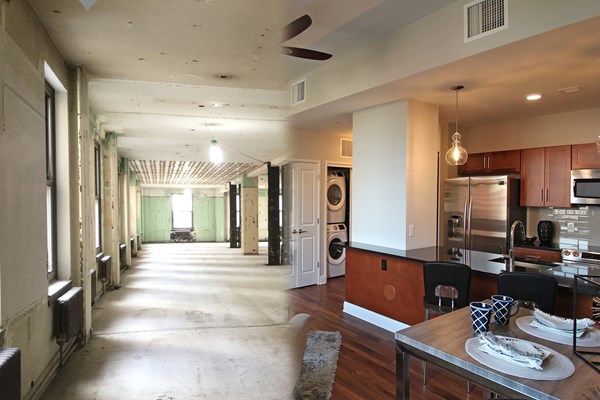
Success in commercial development has always been largely dependent on recognizing changing demand and seizing the opportunity accordingly. Renowned management consultant Peter Drucker said it best...“The entrepreneur always searches for change, responds to it, and exploits it as an opportunity.”
Where office space is concerned, the pandemic has shifted work habits and changed the demand for office space in central business districts. As a result, office buildings around the country are currently seeing the highest vacancy on record. Where will demand be over the next few years? Will businesses need more office space to accommodate closed offices as opposed to open floor plans? Or will work-from-home and flexible workspace continue, resulting in less need for office space?
In either case, changing demands represent new opportunities for developers, as historic office buildings come online, offering the chance for conversion to residential housing. Adaptive reuse of these buildings generally involves lower labor and material costs than those required for new construction. Also, the benefit of qualified historic tax credits (on the backend) adds to the project’s overall attractiveness by reducing net construction costs even further.
Before proceeding, the developer must ask - “Does this project make financial sense?” A thorough preconstruction budget analysis will go a long way toward providing the answer.
The Preconstruction Budget Helps the Developer Identify the “GAP”
The preconstruction budgeting process plays a vital role for any developer seeking tax credits to help finance an adaptive reuse project. Taking time to arrive at a reliable, conceptual budget for the project helps the developer:
Find out if the anticipated revenues are sufficient to support the costs. Identify any “gap” between what is financeable and provides a reasonable equity return, and what the actual project costs are likely to be. Armed with this information, the developer can then engage the services of consultants knowledgeable in the intricacies of federal and state historic tax credit structuring and syndication. Upfront equity can be generated by involving equity investors who provide cash to cover the gap (and later share in the tax credits upon project completion).
Kenneth Kalynchuk, Project Director at Project Management Consultants, (Kalynchuk has worked on many development projects involving historic rehabilitation and adaptive reuse, including the recently completed Terminal Tower historic renovation & adaptive reuse project in Cleveland), explains the financing process as follows:
“We represent the developer in any type of gap financing. These could include historic tax credits, grants, property tax incentives, or low- interest loans. We help the developer structure available financing to close that gap”.
A Brief Overview of Historic Tax Credits
The federal government offers a 20% percent investment tax credit for certified rehabilitation of certified historic buildings through the National Park Service, administered locally through the State Historic Preservation Office. This is a dollar-for-dollar credit applied to federal taxes and not a tax deduction.
In general, only hard and soft costs directly aligned to the existing building are covered. Hard costs would include such things as mechanical, plumbing, HVAC, etc. Soft costs would include developer fees, architectural fees, permits, and application fees. Excluded are ancillary expenses such as acquisition costs, site development, new construction outside the existing building, furniture, and fixtures.
The application process and the factors that determine qualification for tax credits are rather intricate and best left to expert consultation. However, a couple of relevant points are worth mentioning here:
1. Historic Tax Credits (HTC) are a function of costs...which may be unplanned
Tax credits are based on costs. If costs go up, credits go up. While this sounds good, unplanned costs associated with historic building renovations (required under HTC guidelines) are commonly incurred by developers.
“HTC affects the requirements of the building. You will see increases in incremental costs associated with what you can do to the building from a historical perspective. This could include the type of materials you have to use along with additional “soft” costs associated with legal fees and accounting fees,” Kalynchuk cautions.
2. You qualify for tax credits once the project is completed
Developers should know that tax credits are awarded only when the project has been completed. Owners must find upfront money to cover construction costs while waiting months or even years before reaping the promised credits.
Ryan Sommers, Managing Director of Financial Services at Project Management Consultants, explained how the process of finding upfront capital for developers works:
“To turn tax credits into upfront money to cover construction costs, you need to either sell the credit or partner with an equity investor who will come into the project as a minority partner. Bringing that limited partner in produces a financing source”.
His company will work to find those investors for the project. Surprisingly, tax credits are competitive and often awarded through a bidding process. In such cases, the consultant can provide the added benefit of assisting the developer in winning the credits.
Changing Demand = New Opportunities
While changing office space demands may represent new opportunities in the adaptive reuse of historic buildings, developers’ approach should focus on financial viability, avoiding the pitfall of “falling in love with the building.” Emphasizing this point, Kalynchuk cautions, “Regardless of the building’s pedigree, the project must make sense from a dollars-and-cents perspective.”
Emotions must not drive decisions; he stresses. Instead, the project must be based on sound preconstruction budgeting combined with the guidance of consultants experienced in securing tax credits and equity partnerships.